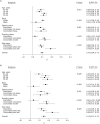Changes in Body Mass Index and Obesity Risk in Married Couples Over 25 Years: The ARIC Cohort Study
- PMID: 26405117
- PMCID: PMC4772434
- DOI: 10.1093/aje/kwv112
Changes in Body Mass Index and Obesity Risk in Married Couples Over 25 Years: The ARIC Cohort Study
Abstract
Married couples might be an appropriate target for obesity prevention interventions. In the present study, we aimed to evaluate whether an individual's risk of obesity is associated with spousal risk of obesity and whether an individual's change in body mass index (BMI; weight in kilograms divided by height in meters squared) is associated with spousal BMI change. We analyzed data from 3,889 spouse pairs in the Atherosclerosis Risk in Communities Study cohort who were sampled at ages 45-65 years from 1986 to 1989 and followed for up to 25 years. We estimated hazard ratios for incident obesity by whether spouses remained nonobese, became obese, remained obese, or became nonobese. We estimated the association of participants' BMI changes with concurrent spousal BMI changes using linear mixed models. Analyses were stratified by sex. At baseline, 22.6% of men and 24.7% of women were obese. Nonobese participants whose spouses became obese were more likely to become obese themselves (for men, hazard ratio = 1.78, 95% confidence interval: 1.30, 2.43; for women, hazard ratio = 1.89, 95% confidence interval: 1.39, 2.57). With each 1-unit increase in spousal BMI change, women's BMI change increased by 0.15 (95% confidence interval: 0.13, 0.18) and men's BMI change increased by 0.10 (95% confidence interval: 0.09, 0.12). Having a spouse become obese nearly doubles one's risk of becoming obese. Future research should consider exploring the efficacy of obesity prevention interventions in couples.
Keywords: change; cohort study; obesity; spouses.
© The Author 2015. Published by Oxford University Press on behalf of the Johns Hopkins Bloomberg School of Public Health. All rights reserved. For permissions, please e-mail: journals.permissions@oup.com.
Figures

References
-
- United States Census Bureau. Selected Social Characteristics in the United States: 2008–2012 American Community Survey 5-year Estimates. http://factfinder2.census.gov/faces/tableservices/jsf/pages/productview.... Updated 2014. Accessed March 26, 2014.
-
- Sutton GC. Do men grow to resemble their wives, or vice versa? J Biosoc Sci. 1993;251:25–29. - PubMed
Publication types
MeSH terms
Grants and funding
- HHSN268201100012C/HL/NHLBI NIH HHS/United States
- HHSN268201100009I/HL/NHLBI NIH HHS/United States
- HHSN268201100010C/HL/NHLBI NIH HHS/United States
- HHSN268201100008C/HL/NHLBI NIH HHS/United States
- HHSN268201100005G/HL/NHLBI NIH HHS/United States
- HHSN268201100008I/HL/NHLBI NIH HHS/United States
- HHSN268201100007C/HL/NHLBI NIH HHS/United States
- HHSN268201100011I/HL/NHLBI NIH HHS/United States
- HHSN268201100011C/HL/NHLBI NIH HHS/United States
- T32 HL007024/HL/NHLBI NIH HHS/United States
- K01 AG043501/AG/NIA NIH HHS/United States
- HHSN268201100006C/HL/NHLBI NIH HHS/United States
- K23HL116601/HL/NHLBI NIH HHS/United States
- HHSN268201100005I/HL/NHLBI NIH HHS/United States
- K24 DK106414/DK/NIDDK NIH HHS/United States
- K23 HL116601/HL/NHLBI NIH HHS/United States
- T32HL007024/HL/NHLBI NIH HHS/United States
- HHSN268201100009C/HL/NHLBI NIH HHS/United States
- HHSN268201100005C/HL/NHLBI NIH HHS/United States
- 2T32DK062707-11A1/DK/NIDDK NIH HHS/United States
- HHSN268201100007I/HL/NHLBI NIH HHS/United States
- T32 DK062707/DK/NIDDK NIH HHS/United States
- K01AG043501/AG/NIA NIH HHS/United States
LinkOut - more resources
Full Text Sources
Other Literature Sources
Medical

